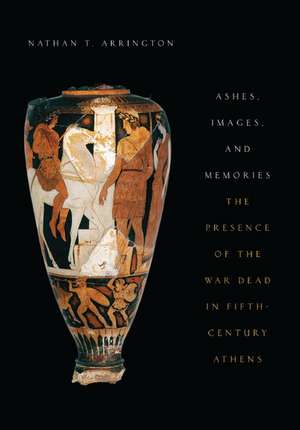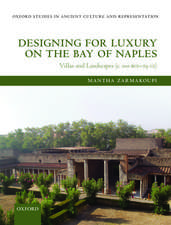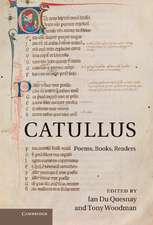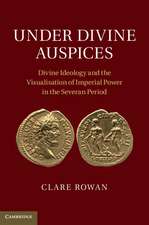Ashes, Images, and Memories: The Presence of the War Dead in Fifth-Century Athens
Autor Nathan T. Arringtonen Limba Engleză Hardback – 15 ian 2015
| Toate formatele și edițiile | Preț | Express |
|---|---|---|
| Paperback (1) | 285.09 lei 32-37 zile | |
| Oxford University Press – 10 ian 2019 | 285.09 lei 32-37 zile | |
| Hardback (1) | 603.40 lei 32-37 zile | |
| Oxford University Press – 15 ian 2015 | 603.40 lei 32-37 zile |
Preț: 603.40 lei
Preț vechi: 691.94 lei
-13% Nou
Puncte Express: 905
Preț estimativ în valută:
115.46€ • 125.81$ • 97.29£
115.46€ • 125.81$ • 97.29£
Carte tipărită la comandă
Livrare economică 14-19 aprilie
Preluare comenzi: 021 569.72.76
Specificații
ISBN-13: 9780199369072
ISBN-10: 0199369070
Pagini: 360
Ilustrații: 85 illus.
Dimensiuni: 236 x 165 x 25 mm
Greutate: 0.8 kg
Editura: Oxford University Press
Colecția OUP USA
Locul publicării:New York, United States
ISBN-10: 0199369070
Pagini: 360
Ilustrații: 85 illus.
Dimensiuni: 236 x 165 x 25 mm
Greutate: 0.8 kg
Editura: Oxford University Press
Colecția OUP USA
Locul publicării:New York, United States
Recenzii
Nathan Arrington's erudite and thoughtful book conjoins a mastery of social history, art history, and field archaeology to explain the role of commemorating war dead in Athenian cultural expression and political development. He offers new and convincing interpretations of the chronology and topography of public rituals honoring the fallen. This has big implications for rethinking the iconography and reception of major monuments and the relationship between war, memory, and democracy. While always sensitive to ancient cultural specificity, Arrington draws telling, and often haunting, parallels between the attempts of democracies ancient and modern to represent to themselves the sacrifice and irreplaceable loss of young men who die fulfilling the purposes of their country. This is a major contribution to the literature on war, art, memory, and ritual. It deserves a wide readership within and beyond ancient studies.
As the centenary of the First World War turns people's attention to the revolution in the culture of commemoration of the war dead effected by that conflict, it is highly appropriate that Nathan Arrington should bring to our attention, as never before, the culture of commemorating the war dead developed in fifth-century Athens. Arrington shows how, by giving the war dead a special status marked by word, deed, and monument, the community from which the dead soldiers had come came to see itself differently. This is not only a challenging example of how to make objects and texts, images and actions, speak to each other, but an eloquent testimony to the extraordinarily pervasive power that the dead can come to exercise over all aspects of a community's life.
'Age shall not weary them, nor the years condemn'. Original, meditative, subtle, beautifully crafted, wide-ranging, and brilliantly synthesizing archaeology, art, and text, Arrington's study offers a magisterial new perspective on an enduring human problem. There is nothing as good or as thoughtful on managing the human cost of war as this.
This is a scholarly and stimulating investigation of commemoration of the war dead in Classical Athens, which not only provides an excellent (and much-needed) analysis of the current state of knowledge about the Athenian patrios nomos, but also argues for a new way of understanding the relationship between those practices and the wider context of Athenian approaches to the commemoration of death and war.
As the centenary of the First World War turns people's attention to the revolution in the culture of commemoration of the war dead effected by that conflict, it is highly appropriate that Nathan Arrington should bring to our attention, as never before, the culture of commemorating the war dead developed in fifth-century Athens. Arrington shows how, by giving the war dead a special status marked by word, deed, and monument, the community from which the dead soldiers had come came to see itself differently. This is not only a challenging example of how to make objects and texts, images and actions, speak to each other, but an eloquent testimony to the extraordinarily pervasive power that the dead can come to exercise over all aspects of a community's life.
'Age shall not weary them, nor the years condemn'. Original, meditative, subtle, beautifully crafted, wide-ranging, and brilliantly synthesizing archaeology, art, and text, Arrington's study offers a magisterial new perspective on an enduring human problem. There is nothing as good or as thoughtful on managing the human cost of war as this.
This is a scholarly and stimulating investigation of commemoration of the war dead in Classical Athens, which not only provides an excellent (and much-needed) analysis of the current state of knowledge about the Athenian patrios nomos, but also argues for a new way of understanding the relationship between those practices and the wider context of Athenian approaches to the commemoration of death and war.
Notă biografică
Nathan T. Arrington is an Assistant Professor of Classical Archaeology at Princeton University.


















